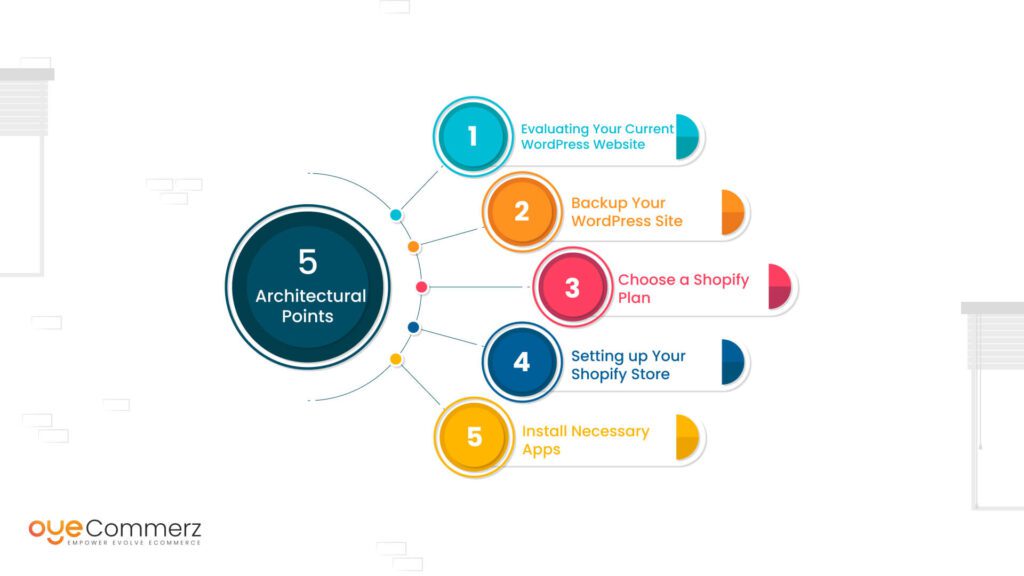Transitioning from WP to Shopify is an exciting step in optimizing your online store operations. As companies grow, selecting a solution that aligns with growth potential, UX, and customization is essential. Shopify has emerged as a favorite for online merchants, providing unmatched flexibility, data protection, and user-friendliness. In this guide, we will delve into the transformative impact of this migration, discuss the benefits, and share practical tips to facilitate a smooth move.
1. Why Switch from WP to Shopify?
The combination of WordPress and WooCommerce, continues to support countless online stores. Nevertheless, as businesses expand, challenges like plugin dependency, security vulnerabilities, and complex setups often obstruct progress. Shopify, specifically created for e-commerce, eliminates these issues with an all-in-one, user-friendly solution. Real data supports this transition—Shopify hosts over 4.4 million stores globally, with a reported 10% boost to sales conversion rates for numerous merchants after migration.
2. Key Benefits of Shopify for E-commerce Success
Shopify’s powerful platform is tailored for expanding brands. Its notable features include:
- Seamless Customization: Shopify offers over 80 expertly crafted themes.
- Built-in Features: Features like Shopify Payments and integrated SEO streamline operations.
- Global Reach: Currency versatility and regional customization empower brands to reach global markets.
Additionally, Shopify delivers an availability percentage of 99.98%, guaranteeing your website is always operational.
3. Preparing for WP to Shopify Migration
Prior to starting the migration process, evaluate your current store. Analyze product data, customer details, and search engine rankings. Resources such as Shopify’s Migration Kit or third-party solutions can simplify this process. Develop a detailed strategy, ensuring all assets—product descriptions, media files, and articles—are optimized for transfer.
4. The Importance of Accurate Data Migration
Data migration is a cornerstone of a smooth transition. When moving from WordPress to Shopify, focus on:
- Inventory Details: SKU, descriptions, and categories.
- Custom Shopify development Client Information: Emails, purchase records, and custom fields.
- SEO Optimization: Preserve meta tags, URLs, and redirects to avoid SEO losses.
Leverage tools such as LitExtension to streamline data transfer while reducing mistakes.
5. Customizing Your Shopify Store
Post-migration, customizing your Shopify store helps it reflects your business identity. Take advantage of Shopify’s intuitive page builder to design pages effortlessly. Shopify's themes are mobile-responsive, providing a seamless UX across platforms—a key point, given 74% of e-commerce traffic is generated by mobile users.
6. How to Protect Your SEO Rankings When Switching Platforms
Search engine optimization is crucial for maintaining your visibility during migration. Shopify is highly optimized for search engines with organized link formatting, built-in optimization tools, and smooth content management. Make sure you:
- Set up URL forwarding for existing links.
- Enhance updated content with keyword-rich content.
- Leverage plugins like Plug in SEO to monitor performance after the switch.
7. Essential Tests After Migrating to Shopify
Once the migration is complete, run detailed checks.
Review: - Website speed (Shopify delivers faster speeds in contrast with WP).
- Functionality of payment gateways and checkout processes.
- Adaptability across devices.
Quality assurance guarantees your store provides a seamless shopping experience from the start.
8. Case Study of a Successful Migration
One such migration success story is Gymshark, a sportswear company that moved to Shopify. Post-migration, the company experienced a 60% increase in mobile sales and significantly lowered site downtime. This showcases the capabilities of Shopify in driving online business success.
9. Overcoming Common Migration Issues
Migration comes with challenges, such as information accuracy and reconfiguring custom functionalities. However, Shopify’s extensive assistance and external professionals Shopify migration pricing simplify the process. Partnering with experienced Shopify developers ensures a trouble-free transition.
10. Making the Switch: The First Step Toward Success
Switching from WP to Shopify represents a strategic approach to online retail. By addressing scalability, streamlining operations, and enhancing the customer experience, Shopify empowers businesses to succeed in challenging industries.
Conclusion
Switching from WP to Shopify offers a smart solution that can greatly enhance your online business performance. With a robust migration plan, the right tools, and professional guidance, you can achieve new growth opportunities.
Ready to make the leap? Let’s discuss how our Shopify migration services can revolutionize your online store. Get in touch today, or ask yourself: Can your business afford to miss out on Shopify’s growth potential?
